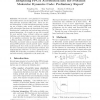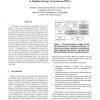FCCM
2006
IEEE
14 years 6 months ago
2006
IEEE
FCCM
2006
IEEE
14 years 6 months ago
2006
IEEE
Field programmable gate arrays (FPGAs), graphics processing units (GPUs) and Sony’s Playstation 2 vector units offer scope for hardware acceleration of applications. Implementin...
FCCM
2006
IEEE
14 years 6 months ago
2006
IEEE
FCCM
2006
IEEE
14 years 6 months ago
2006
IEEE
Abstract: Approximate string matching is fundamental to bioinformatics, and has been the subject of numerous FPGA acceleration studies. We address issues with respect to FPGA imple...
FCCM
2006
IEEE
14 years 6 months ago
2006
IEEE
: We describe a new pipeline for computing non-bonded forces and its integration into the ProtoMol molecular dynamics (MD) code. There are several innovations: a novel interpolatio...
FCCM
2006
IEEE
14 years 6 months ago
2006
IEEE
The growth in size and performance of Field Programmable Gate Arrays (FPGAs) has compelled System-on-aProgrammable-Chip (SoPC) designers to use soft processors for controlling sys...
FCCM
2006
IEEE
14 years 6 months ago
2006
IEEE
We present an architecture and an implementation of an FPGA-based sparse matrix-vector multiplier (SMVM) for use in the iterative solution of large, sparse systems of equations ar...
FCCM
2006
IEEE
14 years 6 months ago
2006
IEEE
In this paper, we investigate a combination of two techniques — instruction coding and instruction re-ordering — for optimizing energy in embedded processor control. We presen...
FCCM
2006
IEEE
14 years 6 months ago
2006
IEEE
This paper presents a novel reconfigurable data flow processing architecture that promises high performance by explicitly targeting both fine- and course-grained parallelism. This...
FCCM
2006
IEEE
14 years 6 months ago
2006
IEEE
Field-Programmable Gate Arrays (FPGAs) are being employed in high performance computing systems owing to their potential to accelerate a wide variety of long-running routines. Par...




